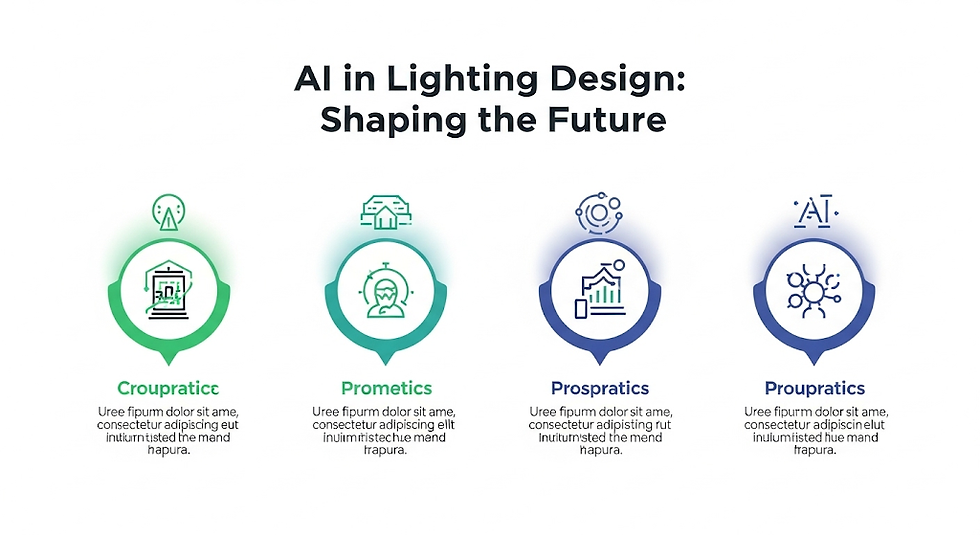How AI Is Shaping the Future of Lighting Design
- Jayant Upadhyaya
- Aug 12
- 3 min read
Updated: Nov 11

Lighting has always been a crucial element in design, but in recent years, the process of creating it has been changing dramatically. Artificial Intelligence (AI) is no longer just a futuristic concept—it’s actively shaping the way designers think about illumination. From architectural spaces to retail displays, and even custom neon signs, AI is enabling more efficient, creative, and personalized lighting solutions than ever before.
AI Brings Precision to Lighting Design
Traditional lighting design often involves a lot of trial and error—measuring brightness, adjusting placements, and swapping out fixtures until the right look is achieved.
AI changes that process by using algorithms to simulate lighting in a space before a single bulb is installed. Designers can model how natural and artificial light will interact at different times of the day, taking into account reflections, shadows, and even color temperature.
This precision means fewer revisions, less waste, and a design that meets both aesthetic and functional needs from the start.
From Data to Design: How AI Thinks About Light
One of the most powerful things AI brings to lighting design is data analysis. AI systems can assess everything from energy efficiency to human behavioral patterns within a space. For example, in a retail setting, AI might suggest brighter lighting in display areas where customers linger and softer tones in areas meant for relaxation.
In event spaces, AI can even create adaptive lighting systems that change in real time based on the type of performance or audience reaction. This level of customization was nearly impossible to achieve just a decade ago without extensive manual programming.
Practical Ways AI Is Used in Lighting Design
AI isn’t just about big, futuristic projects—it’s finding its way into everyday applications. Some common uses include:
Smart home lighting systems that learn user preferences.
Commercial space optimization that balances ambiance with energy savings.
Interactive installations where lights respond to movement or sound.
Event lighting programmed to shift dynamically during performances.
Neon and signage customization, allowing designers to visualize exact glow, color blends, and text styles before production.
Sustainability Meets Style
AI’s role in lighting isn’t purely about aesthetics—it’s also a powerful tool for sustainability. By analyzing patterns of use and adjusting accordingly, AI can significantly reduce energy waste.
According to the U.S. Department of Energy, LED lighting combined with smart controls can reduce energy consumption by up to 50% compared to traditional systems.
This is a big win for both the environment and budgets, as businesses and homeowners alike look for ways to cut costs while reducing their carbon footprint.
AI’s Role in Creative Lighting
Designers are finding that AI doesn’t limit creativity—it expands it. AI can generate mood boards, suggest color palettes, and even simulate how various light sources will look with specific materials or finishes.
For example, when designing custom neon signs, AI tools can instantly render multiple versions so clients can choose the perfect style without costly prototypes.
This creative flexibility also makes it easier to experiment with bold ideas—designers can see the impact of unconventional shapes, gradients, or motion effects before committing. Agencies can use white label digital signage to create engaging lighting and digital displays for their clients.
The Future: AI Is the Future of Lighting Design
As AI technology continues to develop, we can expect lighting to become even more interactive and immersive. Imagine walking into a restaurant where the lighting adjusts subtly to your table’s mood, or working in an office where lights shift throughout the day to match your body’s circadian rhythm.
For commercial and entertainment spaces, AI could make lighting a central part of storytelling—think live performances where the lighting doesn’t just follow cues, but actively responds to the music, audience, or even weather conditions outside.
In short, AI is Future of lighting design smarter, greener, and more creative. The combination of human artistry and machine intelligence is opening possibilities we’ve never seen before—and the glow on the horizon looks promising.






Comments